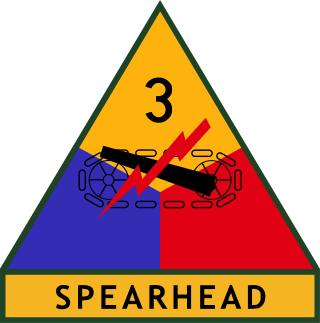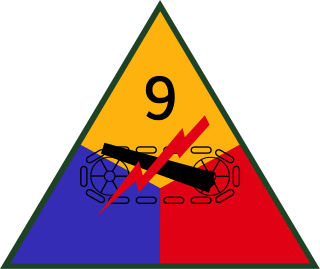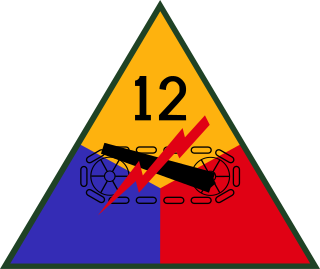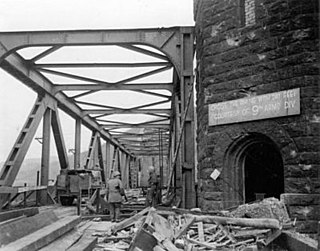
The 3rd Armored Division was an armored division of the United States Army. Unofficially nicknamed the "Third Herd", the division was first activated in 1941 and was active in the European Theater of World War II. The division was stationed in West Germany for much of the Cold War and also participated in the Persian Gulf War. On 17 January 1992, still in Germany, the division ceased operations. In October 1992, it was formally inactivated as part of a general drawing down of U.S. military forces at the end of the Cold War.

The 6th Armored Division was an armored division of the United States Army during World War II. It was formed with a cadre from the 2nd Armored Division.

The 8th Armored Division was an armored division of the United States Army that served in the European Theater of World War II.

The 9th Armored Division was an armored division of the United States Army during World War II. In honor of their World War II service, the 9th was officially nicknamed the "Phantom Division."

The 12th Armored Division was an armored division of the United States Army in World War II. It fought in the European Theater of Operations in France, Germany and Austria, between November 1944 and May 1945.

The 14th Armored Division was an armored division of the United States Army assigned to the Seventh Army of the Sixth Army Group during World War II. It remains on the permanent roll of the Regular Army as an inactive division, and is eligible for reactivation. The division is officially nicknamed the "Liberators".

The 20th Armored Division was an armored division of the United States Army that fought in World War II. It was activated on 15 March 1943 at Camp Campbell in Kentucky.

The 17th Airborne Division, "The Golden Talons", was an airborne infantry division of the United States Army during World War II, commanded by Major General William M. Miley.

The 65th Infantry Division—nicknamed the "Battle-Axe Division"—was an infantry division of the United States Army that served in World War II. Its shoulder patch is a white halberd on a blue shield.

The 103rd Infantry Division was a unit of the United States Army that served in the U.S. Seventh Army of the 6th Army Group during World War II.

The 79th Infantry Division was an infantry formation of the United States Army Reserve in World Wars I and II.

The 63rd Infantry Division was an infantry division of the United States Army that fought in Europe during World War II. After the war it was inactivated, but later the division number and shoulder sleeve insignia were authorized for use by the 63rd Army Reserve Command (ARCOM).

The 37th Armor is an armor (tank) regiment of the United States Army. It is often remembered as the successor to the 37th Tank Battalion, 4th Armored Division, commanded by then Lieutenant Colonel Creighton Abrams during World War II.
The 235th Mechanized Infantry Brigade, formerly the 79th Division, is a military formation of the People's Liberation Army Ground Force. It's now a maneuvering brigade of the PLA 71st Group Army.

The Battle of Remagen was an 18-day battle during the Allied invasion of Germany in World War II from 7 to 25 March 1945 when American forces unexpectedly captured the Ludendorff Bridge over the Rhine intact. They were able to hold it against German opposition and build additional temporary crossings. The presence of a bridgehead across the Rhine advanced by three weeks the Western Allies' planned crossing of the Rhine into the German interior.
The 79th Infantry Division(79. Infanterie-Division) was an infantry division of Nazi Germany's Wehrmacht during World War II.
The 773rd Tank Destroyer Battalion was a tank destroyer battalion of the United States Army active during the Second World War.

117th Jäger Division was a German infantry division of World War II. The division was formed in April 1943 by the reorganization and redesignation of the 717th Infantry Division. The 717th Division had been formed in April 1941. It was transferred to Yugoslavia in May 1941, to conduct anti partisan and Internal security operations.

The 9th Infantry Division Pasubio was an infantry division of the Royal Italian Army during World War II. The Pasubio was classified as an auto-transportable division, meaning it had some motorized transport, but not enough to move the entire division at once. The division was formed as an infantry division in 1934, reorganized as auto-transportable division in 1939 and mobilized in August 1940. It was named for the battles on Pasubio during World War I. Its 79th Infantry Regiment and 8th Artillery Regiment were made up of men from Verona, while the ranks of the 80th Regiment were filled with men from Mantua. Its I CC.NN. Battalion "Sabauda" was made up of Blackshirt volunteers from Turin.
The 36th Guards Rifle Division was a Guards infantry division of the Red Army during World War II. It was formed from the 9th Airborne Corps in August 1942 as a result of the Soviet need for troops to fight in the Battle of Stalingrad. The division was awarded the honorific Verkhnedneprovsk for its crossing of the Dnieper in September 1943 near that town, later receiving the Order of the Red Banner and the Order of Suvorov, 2nd class, for its actions in the Uman–Botoșani Offensive in March 1944. It fought in the siege of Budapest during late 1944 and early 1945, receiving the Order of Kutuzov, 2nd class, for its actions. In late 1945, it was converted into the 24th Guards Mechanized Division. Stationed in Romania, it was disbanded in early 1947.


















